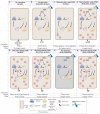Mycovirus-encoded suppressors of RNA silencing: Possible allies or enemies in the use of RNAi to control fungal disease in crops
- PMID: 37746227
- PMCID: PMC10512228
- DOI: 10.3389/ffunb.2022.965781
Mycovirus-encoded suppressors of RNA silencing: Possible allies or enemies in the use of RNAi to control fungal disease in crops
Abstract
Plants, fungi, and many other eukaryotes have evolved an RNA interference (RNAi) mechanism that is key for regulating gene expression and the control of pathogens. RNAi inhibits gene expression, in a sequence-specific manner, by recognizing and deploying cognate double-stranded RNA (dsRNA) either from endogenous sources (e.g. pre-micro RNAs) or exogenous origin (e.g. viruses, dsRNA, or small interfering RNAs, siRNAs). Recent studies have demonstrated that fungal pathogens can transfer siRNAs into plant cells to suppress host immunity and aid infection, in a mechanism termed cross-kingdom RNAi. New technologies, based on RNAi are being developed for crop protection against insect pests, viruses, and more recently against fungal pathogens. One example, is host-induced gene silencing (HIGS), which is a mechanism whereby transgenic plants are modified to produce siRNAs or dsRNAs targeting key transcripts of plants, or their pathogens or pests. An alternative gene regulation strategy that also co-opts the silencing machinery is spray-induced gene silencing (SIGS), in which dsRNAs or single-stranded RNAs (ssRNAs) are applied to target genes within a pathogen or pest. Fungi also use their RNA silencing machinery against mycoviruses (fungal viruses) and mycoviruses can deploy virus-encoded suppressors of RNAi (myco-VSRs) as a counter-defence. We propose that myco-VSRs may impact new dsRNA-based management methods, resulting in unintended outcomes, including suppression of management by HIGS or SIGS. Despite a large diversity of mycoviruses being discovered using high throughput sequencing, their biology is poorly understood. In particular, the prevalence of mycoviruses and the cellular effect of their encoded VSRs are under-appreciated when considering the deployment of HIGS and SIGS strategies. This review focuses on mycoviruses, their VSR activities in fungi, and the implications for control of pathogenic fungi using RNAi.
Keywords: HIGS; RNA interference; SIGS; dsRNA; mycovirus; suppressor of silencing.
Copyright © 2022 Rodriguez Coy, Plummer, Khalifa and MacDiarmid.
Conflict of interest statement
The authors declare that the research was conducted in the absence of any commercial or financial relationships that could be construed as a potential conflict of interest.
Figures

Similar articles
-
Exploring the challenges of RNAi-based strategies for crop protection.Adv Biotechnol (Singap). 2024 Jul 15;2(3):23. doi: 10.1007/s44307-024-00031-x. Adv Biotechnol (Singap). 2024. PMID: 39883232 Free PMC article. Review.
-
Spray-Induced Silencing of Pathogenicity Gene MoDES1 via Exogenous Double-Stranded RNA Can Confer Partial Resistance Against Fungal Blast in Rice.Front Plant Sci. 2021 Nov 26;12:733129. doi: 10.3389/fpls.2021.733129. eCollection 2021. Front Plant Sci. 2021. PMID: 34899771 Free PMC article.
-
Cross-kingdom RNA trafficking and environmental RNAi-nature's blueprint for modern crop protection strategies.Curr Opin Microbiol. 2018 Dec;46:58-64. doi: 10.1016/j.mib.2018.02.003. Epub 2018 Mar 14. Curr Opin Microbiol. 2018. PMID: 29549797 Free PMC article. Review.
-
Study on the efficiency of dsRNAs with increasing length in RNA-based silencing of the Fusarium CYP51 genes.RNA Biol. 2020 Apr;17(4):463-473. doi: 10.1080/15476286.2019.1700033. Epub 2020 Jan 13. RNA Biol. 2020. PMID: 31814508 Free PMC article.
-
Synthesizing Fluorescently Labeled dsRNAs and sRNAs to Visualize Fungal RNA Uptake.Methods Mol Biol. 2020;2166:215-225. doi: 10.1007/978-1-0716-0712-1_12. Methods Mol Biol. 2020. PMID: 32710411
Cited by
-
Reexamining the Mycovirome of Botrytis spp.Viruses. 2024 Oct 21;16(10):1640. doi: 10.3390/v16101640. Viruses. 2024. PMID: 39459972 Free PMC article.
-
The Prevalence of Killer Yeasts in the Gardens of Fungus-Growing Ants and the Discovery of Novel Killer Toxin named Ksino.bioRxiv [Preprint]. 2024 Oct 14:2024.10.14.618321. doi: 10.1101/2024.10.14.618321. bioRxiv. 2024. PMID: 39463942 Free PMC article. Preprint.
-
Spray-induced gene silencing for crop protection: recent advances and emerging trends.Front Plant Sci. 2025 Feb 20;16:1527944. doi: 10.3389/fpls.2025.1527944. eCollection 2025. Front Plant Sci. 2025. PMID: 40051878 Free PMC article. Review.
-
Mycologists and Virologists Align: Proposing Botrytis cinerea for Global Mycovirus Studies.Viruses. 2024 Sep 18;16(9):1483. doi: 10.3390/v16091483. Viruses. 2024. PMID: 39339959 Free PMC article. Review.
-
Molecular Characterization of Two Totiviruses from the Commensal Yeast Geotrichum candidum.Viruses. 2023 Oct 25;15(11):2150. doi: 10.3390/v15112150. Viruses. 2023. PMID: 38005831 Free PMC article.
References
-
- Abdurakhmonov I. Y. (2016). RNA Interference – a hallmark of cellular function and gene Manipulation.RNA interference (London: IntechOpen; ).
-
- Arakawa M., Nakamura H., Uetake Y., Matsumoto N. (2002). Presence and distribution of double-stranded RNA elements in the white root rot fungus Rosellinia necatrix . Mycoscience. 43:1, 21–26. doi: 10.1007/s102670200004 - DOI
-
- Aulia A., Andika I. B., Kondo H., Hillman B. I., Suzuki N. (2019). A symptomless hypovirus, CHV4, facilitates stable infection of the chestnut blight fungus by a coinfecting reovirus likely through suppression of antiviral RNA silencing. Virology. 533, 99–107. doi: 10.1016/j.virol.2019.05.004 - DOI - PubMed
Publication types
LinkOut - more resources
Full Text Sources

